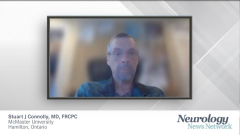
Evaluating Cost-Effectiveness of Different Endovascular Therapy [EVT] Strategies
Therapeutic and financial considerations of EVT are explored by a medical expert.
This is a video synopsis/summary of a Post Conference Perspectives involving Kevin Sheth, MD.
Sheth provides background that recent trials suggest bypassing alteplase and doing endovascular therapy strategies (EVT)alone in eligible patients may be preferable, but it is still common to give both intravenous alteplase and EVT when possible. This abstract took an alternate approach by evaluating the economics.
The methods involved a 10-year Monte Carlo simulation with a decision tree and a Markov model estimating total cost, quality-adjusted life years (QALYs), and incremental net monetary benefit (INMB) of alteplase before EVT versus EVT alone. Functional outcomes were from pooled randomized controlled trials. Alteplase before EVT was considered cost-effective if INMB was positive at a threshold of $84,000 per QALY gained.
Key findings were that alteplase before EVT versus EVT alone was associated with a 0.02 QALY loss but $236 lower cost over 10 years. For Western Hemisphere or Dutch patients only, alteplase before EVT yielded 0.2 to 0.3 QALY gains at a higher cost of $5000 to $11,000, meeting cost-effectiveness thresholds in 65% to 100% of simulations.
Sheth concludes that while absolute differences are modest, geographic setting significantly impacts results, likely relating to poststroke disability costs. This demonstrates the value of economic analyses to inform system-level stroke care policies, which may reasonably differ across health care systems.
Video synopsis is AI-generated and reviewed by Neurology Live editorial staff.
Newsletter
Keep your finger on the pulse of neurology—subscribe to NeurologyLive for expert interviews, new data, and breakthrough treatment updates.

![Video 4 - "Computed Tomography Perfusion [CTP] In Stroke Management"](https://cdn.sanity.io/images/0vv8moc6/neurolive/22a5299dacb2d682893012688ede0e3cda33a713-1920x1080.png?w=240&fit=crop&auto=format)


































